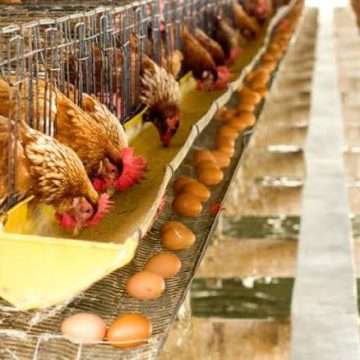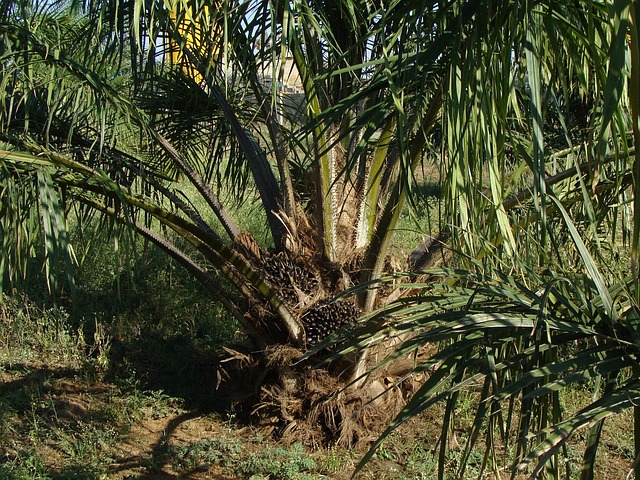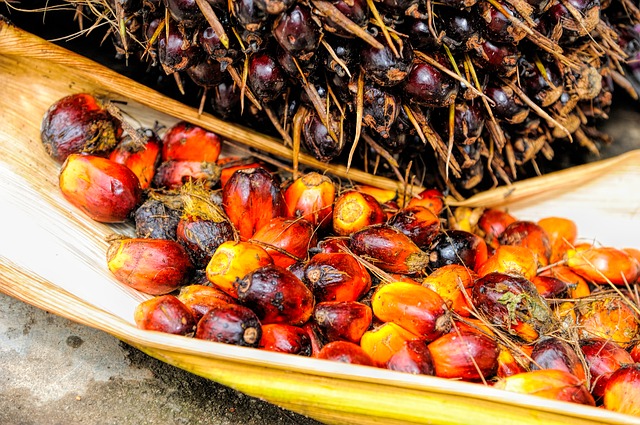The Oil palm, scientific name – Elaeis guineensis is another member of the palm family.
There are about 2,000 species, mostly confined to the tropical regions.
Oil palms thrive well in tropical rain forests and are natives of West Africa.
Because of their economic value, they are grown in many other parts of the tropics.
Parts of Oil Palm Tree
The oil palm tree basically consists of the Trunk, leaves, roots, and fruits.
The Trunk
The oil palm reaches an average height of about nine meters under plantation conditions, but the tall ones can reach a height of about thirty meters in forests.
The single erect trunk has the same thickness throughout its length and is generally rough because it is covered by persistent leaf bases.
The leaf bases fall off from the trees between the ages of thirteen and twenty.
The trunk does not show secondary growth.
When the palm tree is fallen, the oil palm trunk is a solid waste that can be very useful in industries.
The fiber can be processed, and the sugar is known to be processed to make ethanol and other substances.
Oil palm trunk can also be processed to make plywood and you can find these endproducts on Amazon and other e-stores.
The Roots
The oil palm root system is like that of a coconut palm. The Oil palm has numerous adventitious roots that are seldom found below a depth of one meter from the ground.
Some of the roots appear above the ground-level forming a network around the tree.
A common disease of the oil palm root is rot.
The Leaves
The oil palm leaf (frond) structure and properties are similar to the coconut palm.
The Oil pam trunk carries a crown of 45 to 50 compound leaves or fronds at the top.
Each leaf or frond may be over 180cm long and is similar in appearance to that of the coconut palm.
The petiole of each compound leaf bears short lateral spines (not found in the coconut palm) and the base of each petiole broadens out to form a strong fibrous sheath.
Young tender leaves of oil palm are pale yellow in color, but as they unfold they take on a pale green color.
This deepens to a dark green as they mature.
The old oil palm leaves turn brown and fall off from the stem when they reach maturity, leaving distinct leaf bases which will drop off when the oil palm tree matures.
As older leaves continue to shed, new fronds grow from the stem apex.
The Inflorescence
The oil palm is monoecious and starts to flower at the age of five.
The male and female flowers occur separately in two inflorescences on the same plant.
Occasionally, both the male and female flowers appear on the same inflorescence.
In such a case, the male flowers appear at the tip of the inflorescence, while the female flowers at the base.
The male inflorescences grow from the axils of younger leaves.
Each spikelet has between 700 and 1200 male flowers which begin to open from the base to the tip of the spikelet.
Every male flower has six perianth lobes, three stamens with their filaments joined at the base, and six anthers.
A rudimentary ovary can be seen at the base of the flower.
Before it opens, each male flower is protected by a triangular scale-like bract.
The female inflorescences grow from the axils of older leaves.
Each is composed of many thick and fleshy spikelets.
Between 12 and 30 female flowers are arranged spirally around the rachis of a spikelet.
There are abortive male flowers beside each female flower, all of which are protected by a bract that is elongated to a spine.
The female flower has 6 perianth lobes, an ovary with a single functional carpel, and a stigma with three lobes.
All these are enclosed by two or three bracteoles.
Rudimentary stamens are also found in the female flower.
The Fruit
The odorless flowers of the soil palm are usually wind-pollinated, although they are also known to be pollinated by insects.
After pollination, fertilization takes place.
The ovaries of the female inflorescence develop into a large compact bunch which may contain more than 1,000 fruits.
Each fruit is a drupe, about 2.5 to 5cm long and 2 to 2.5cm in diameter.
The pericarp of the drupe is made up of three layers – an outer epicarp, a middle mesocarp which is fibrous ad oily, and an inner stony endocarp or shell.
The latter encloses one seed known as the kernel. When the fruits are ripe, they become red with a persistent dark brown stigma.
The ‘nut’ consists of a hard shell, or endocarp, and a kernel.
There are fibers running longitudinally from one end of the shell to the other, and they end in a tuft at the base.
Each ‘nut’ has three germ pores, but only one is functional.
The kernel is composed of layers of hard oily endosperm and a test.
The test is dark brown in color and is also covered with fibers.
Embedded in the endosperm is a tiny embryo, about 3mm long.
Germination and Growth
The germination and healthy growth of the oil palm tree require hot temperature, water, and soil rich in nutrients.
The developing embryo of oil palm seed has only one cotyledon that does not grow into a green photosynthetic organ.
It remains below the surface of the soil during germination.
Within the seed, the cotyledons develop and grow into a spongy absorbent organ called the haustorium.
It draws upon the food reserve in the endosperm, dissolves the food, and passes it on to the plumule and radicle, the growing parts of the embryo.
As the seed germinates, the embryo emerges from the germ pore.
The radicle grows out first in a downward direction, while the plumule follows by growing upwards.
The shoot system then develops from the plumule and the root system from the radicle.
The shoot grows in the width at first. It produces large leaves at its apex and adventitious roots at its base.
The stem takes several years to attain its maximum girth, after which it begins to grow in height rapidly.
The rate of growth of the oil palm depends on the environment.
Under the extreme shade, the growth is very slow, but under normal plantation conditions, the average increase in height will be from 30cm to 60cm per year.
The oil palm flowers from August to October. Each inflorescence takes about eight months to produce ripe fruits.
Harvesting takes place from April to June.
Economic Importance
Commercial palm oil is extracted from the fibrous, oily mesocarp.
Palm kernel oil is extracted from the oily endosperm of the kernel.
Both palm oil and palm kernel oil are extensively used in the manufacture of margarine, cooking oil, confectionery fat, cooking fat, and soap.
Palm oil is also used in the processing of tinplating.
Palm kernel cake, the meal after the extraction of oil, is a good cattle feed.
In many parts of West Africa, the oil palm is tapped for wine which is consumed largely by the urban dwellers and villagers.
The wine contains Vitamin A to the African natives who use the oil for cooking.
The dried leaves of the oil palm are used for thatching the roofs of houses; the petioles and rachises for fencing.









